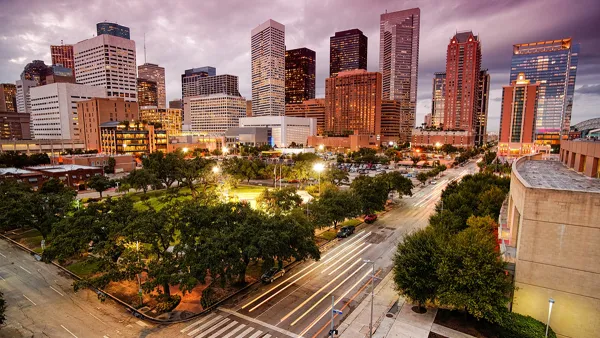Funding bus rapid transit is the fastest and most cost-effective way to improve U.S. transit systems and bring transit within reach for more Americans.

Writing in Curbed, Alissa Walker asserts that “To get the U.S. moving again, 2023 needs to be the year of the bus.” And it very well could be, if a bill introduced by Congresswoman Cori Bush passes.
The Bus Rapid Transit Act would allocate $12 billion per year for five years to BRT projects, funneling dollars directly to transit operations and helping cities invest in the design and construction of new BRT systems, including overhauls of current bus routes.
Bush also introduced an identical bill aimed at light rail, but, Walker points out, “the BRT program gives cities more flexibility and more options.” As an example, “Indianapolis, a city that doesn’t have a rail system, built its wildly popular 13-mile IndyGo BRT line in just a few years and at a fraction of what rail would have cost.”
Because not all U.S. cities have rail systems, and rail is vastly more expensive than bus infrastructure, BRT has the potential to transform transit systems and open up public transportation as a convenient and efficient option to more Americans. Plus, Walker writes, “More buses mean cleaner air, fewer emissions, and safer streets because cities with higher rates of transit ridership have lower rates of traffic deaths.”Ultimately, boosting BRT would benefit riders, transit agencies, traffic, and the environment.
FULL STORY: Make 2023 the Year of the Bus

National Parks Layoffs Will Cause Communities to Lose Billions
Thousands of essential park workers were laid off this week, just before the busy spring break season.

Retro-silient?: America’s First “Eco-burb,” The Woodlands Turns 50
A master-planned community north of Houston offers lessons on green infrastructure and resilient design, but falls short of its founder’s lofty affordability and walkability goals.

Delivering for America Plan Will Downgrade Mail Service in at Least 49.5 Percent of Zip Codes
Republican and Democrat lawmakers criticize the plan for its disproportionate negative impact on rural communities.

Test News Post 1
This is a summary

Test News Headline 46
Test for the image on the front page.

Balancing Bombs and Butterflies: How the National Guard Protects a Rare Species
The National Guard at Fort Indiantown Gap uses GIS technology and land management strategies to balance military training with conservation efforts, ensuring the survival of the rare eastern regal fritillary butterfly.
Urban Design for Planners 1: Software Tools
This six-course series explores essential urban design concepts using open source software and equips planners with the tools they need to participate fully in the urban design process.
Planning for Universal Design
Learn the tools for implementing Universal Design in planning regulations.
EMC Planning Group, Inc.
Planetizen
Planetizen
Mpact (formerly Rail~Volution)
Great Falls Development Authority, Inc.
HUDs Office of Policy Development and Research
NYU Wagner Graduate School of Public Service





























